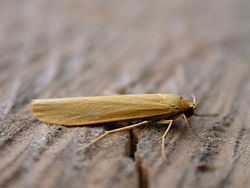| Manulea lutarella | |
|---|---|
 | |
 | |
| Scientific classification | |
| Kingdom: | Animalia |
| Phylum: | Arthropoda |
| Class: | Insecta |
| Order: | Lepidoptera |
| Superfamily: | Noctuoidea |
| Family: | Erebidae |
| Subfamily: | Arctiinae |
| Genus: | Eilema |
| Species: | E. lutarella |
| Binomial name | |
| Eilema lutarella | |
| Synonyms | |
| |
Eilema lutarella is a species of moth in the family Erebidae. It is found in North Africa through Central Europe up to the area surrounding the Amur River and Sakhalin. In the north, it is found up to Scandinavia, Komi Republic in European Russia, Vitim river in Siberia.
Contents
The wingspan is 27–30 mm. The moth flies from July to August depending on the location.
The larvae feed on lichen.